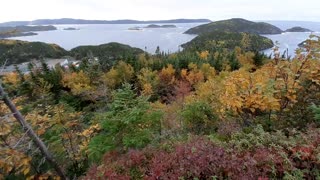Premium Only Content

Autumn leaf rake and burn - Timelapse
Autumn leaf color is a phenomenon that affects the normal green leaves of many deciduous trees and shrubs by which they take on, during a few weeks in the autumn season, various shades of yellow, orange, red, purple, and brown.
In some areas of Canada and the United States, "leaf peeping" tourism is a major contribution to economic activity. This tourist activity occurs between the beginning of color changes and the onset of leaf fall, usually around September and October in the Northern Hemisphere and April to May in the Southern Hemisphere.
A green leaf is green because of the presence of a pigment known as chlorophyll. When abundant in the leaf's cells, as during the growing season, the chlorophyll's green color dominates and masks out the colors of any other pigments that may be present in the leaf. Thus, the leaves of summer are characteristically green.
Chlorophyll has a vital function: it captures solar rays and uses the resulting energy in the manufacture of the plant's food – simple sugars which are produced from water and carbon dioxide. These sugars are the basis of the plant's nourishment – the sole source of the carbohydrates needed for growth and development. In their food-manufacturing process, the chlorophylls break down, thus are being continually "used up". During the growing season, however, the plant replenishes the chlorophyll so that the supply remains high and the leaves stay green.
As autumn approaches, with daylight hours shortening and temperatures cooling, the veins that carry fluids into and out of the leaf are gradually closed off as a layer of special cork cells forms at the base of each leaf. As this cork layer develops, water and mineral intake into the leaf is reduced, slowly at first, and then more rapidly. During this time, the amount of chlorophyll in the leaf begins to decrease. Often, the veins are still green after the tissues between them have almost completely changed color.
Deciduous plants were traditionally believed to shed their leaves in autumn primarily because the high costs involved in their maintenance would outweigh the benefits from photosynthesis during the winter period of low light availability and cold temperatures. Other factors involved include insect predation, water loss, and damage from high winds or snowfall.
-
 4:55
4:55
AmplifiedLIFE
8 months agoPredictions for 2025 & Beyond from Beyond
1223 -
 27:01
27:01
Cr8urCanvas
3 years agoSingle Yellow Autumn Leaf
33 -
 0:26
0:26
NewHampshire603
3 years agoAutumn Beauty
648 -
 0:06
0:06
Our Outdoor Life With Danny & Lorraine
3 years agoAutumn Colors
6913 -
 0:55
0:55
Vothuy
3 years agoHello Autumn
30 -
 3:05:00
3:05:00
TimcastIRL
8 hours agoTrump Floats Accepting 600,000 Chinese Student Visas, MAGA Uproar | Timcast IRL
209K147 -
 8:44:47
8:44:47
SpartakusLIVE
13 hours ago$20,000 Hide and Seek Tourney w/ Stonemountain64 || #1 Rat wins the BIG CHEESE
69.9K -
 2:34:02
2:34:02
Barry Cunningham
9 hours agoLISA COOK | ADAM SCHIFF | LETITIA JAMES | ARE THEY BEING SACRIFICED BY THE DEEP STATE?
102K59 -
 1:36:19
1:36:19
Flyover Conservatives
17 hours agoOnly 17% of Millennials Hit These 5 Adult Milestones—Why?; What If Childhood Trauma Is Behind Your Health Problems? - Dr. Troy Spurrill | FOC Show
40.4K4 -
 4:49:04
4:49:04
HogansAlleyHero
18 hours ago💥CHASING DOPAMINE💥✅TRUMP SAYS BATTLEFIELD IS THE BEST✅
51.8K3